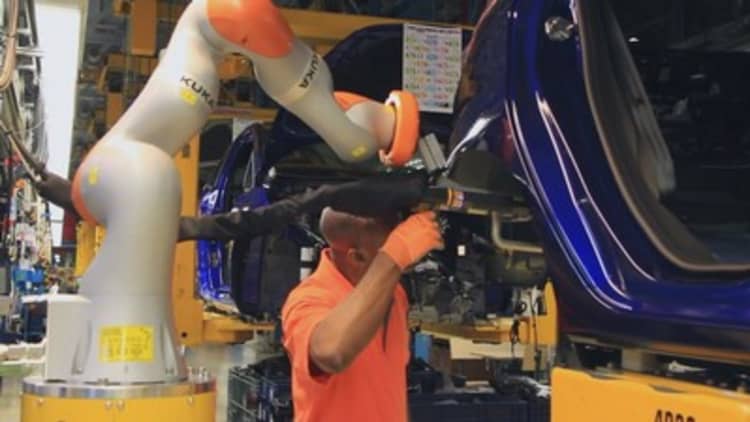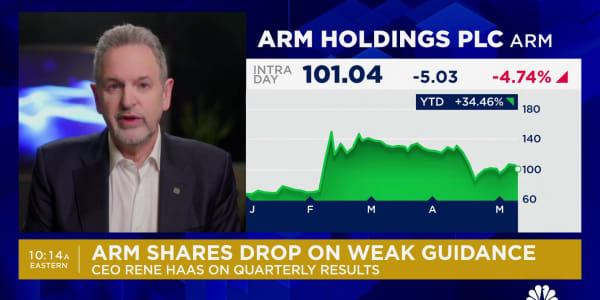
At Ford's factory in Cologne, Germany, a new kind of robot is sitting by the assembly line helping manufacture the legendary automaker's cars. But these collaborative robots, or co-bots, aren't replacing their human counterparts at this Ford Fiesta plant. Instead, they're working side by side with 4,000 Ford factory workers, and not for them.
"The workforce is really helping us define how they can contribute more by using the collaborative robots to do some of the more mundane, simple, heavy-exertion tasks, which in turn allows them to use more of their creativity and their minds to take us to the next level, " said Bruce Hettle, vice president of manufacturing and labor affairs at Ford.
For decades the auto industry has led the way in using robots in their factories, a trend that continues today. According to the Robotic Industries Association, North American automotive companies have already spent $282 million on robots in 2016, after having spent a combined $436 million on robots the previous year. These robots are the traditional industrial robots, colossal machines that pose a safety risk to humans and therefore need to be fenced in to protect workers as they complete their tasks.
"Upwards of 1,000 robots can be found in a modern [auto] assembly plant," said Jay Baron, CEO of the Center for Automotive Research. These machines do things like attach doors, apply paint and load engines. "Without this automation, our factories would have been obsolete a long time ago. Automation is necessary for safety, quality and productivity."
The next era in robotics
Since 2010, vehicle production in the United States has increased by an average of about 16 percent annually because of industrial robots, according to Bastian Solutions. One recent study in the UK, which analyzed the use of industrial robots over a 14-year period across manufacturing industries in countries, including the United States, found that labor productivity grew each year.
Recently, however, car companies have begun shifting tactics. General Motors, Mercedes-Benz, BMW and now Ford are all experimenting with or have been using co-bots in their factories. Unlike their bulkier brethren, co-bots are smaller robots — think of the Germany-based Kuka Robotics' "arm" robot or the Baxter robot made by Boston-based Rethink Robotics — sometimes no more than 3 feet tall. They're designed to work with humans, not for humans.
At Ford's factory in Germany, where Kuka-built robots were installed at two workstations, co-bots are assisting factory-floor workers to fit shock absorbers into the wheel arches of Ford Fiesta cars. They're a harbinger of what's now happening at car companies: assigning mundane or physically exerting tasks, such as material handling or welding, to robotic workers, which free up human employees to think about how to personalize and customize cars for customers, something consumers are increasingly demanding.
More from Net/Net:
How Pepsi's CEO and CFO fight
Fmr CIA official: Biggest threat facing our nation right now is an election-night hack
Cities splurge on smart technology
"It's not just the use of co-bots — it's the reduction of industrial robots," said Frank Tobe, a robotics expert and publisher of "The Robot Report." "The traditional caged robot at auto factories is becoming obsolete, because every car is different from every other car."
Manufacturing precisely configured vehicles where customers choose details like the trim of the dash or the caps of tire valves is not a task for large industrial robots, which have trouble adapting to an age of mass customization in part because they constantly have to be reprogrammed.
Market analysts at Barclays predict the co-bot industry is poised for rapid growth. In 2015, $116 million was spent worldwide on co-bots. By 2020, Barclays predicts sales of co-bots around the globe will near $3 billion.
"Autos is the largest end market for robots today, but in the future the general industry market will be larger," said James Stettler, an analyst at Barclays Capital who co-authored the report "The Rise of Co-Bots II — Lift-Off in 2016" with colleagues Lars Brorson, Rizk Maidi and David Vos last February.
Automakers are leading the way in the adoption of co-bots, which they say are more cost-effective than industrial robots. The average selling price of a co-bot is close to $30,000, a number expected to drop to $18,500 by 2020. Automakers also prefer the flexibility that comes with co-bots, which don't need to be in a fixed factory location caged in or cordoned off and therefore can be rolled around to different parts of the factory.
"You can have them do a task in the morning and an entirely different task at a different location in the afternoon," Tobe said.
Car companies say they're also safer for human workers, in large part due to sensors that detect when fingers or a hand is in the way. Some co-bots also have "deep learning" capabilities through artificial intelligence, which allow them to figure out their tasks while on the job instead of being programmed beforehand.
Jeff Burnstein, president of the Robotic Industries Association in Ann Arbor, Michigan, says the potential upsides of integrating co-bots on the factory floor are the reason auto companies are giving them a hard look.
"I'm sure all automakers are looking into co-bots because of the promise: low-cost, quick to set up and operate, minimal programming, don't need a lot of floor space to work safely around people," he said.
Still, it's the early days of collaborative robotics. Burnstein predictions that the global market for co-bots will reach $3 billion by the end of the decade are overly optimistic.
"This collaborative robot technology is still relatively new," he said. "Whether or not they're suitable for all applications, whether they're too slow, whether they are as reliable as industrial robots, whether they're truly going to be safe — there's a lot of hurdles still."
The factory floor in transition
But the concern from the manufacturing sector is that robots of any kind are coming to replace jobs — something with which the auto industry is quite familiar. From 1985 to 2015, hourly employment among Detroit's Big Three — General Motors, Ford and Fiat Chrysler — has declined from about 600,000 to 137,000, according to the Center for Automotive Research. Since 2000, more than 307,000 auto-manufacturing jobs have been lost in the United States, according to the Bureau of Labor Statistics.
"You can look out on the shop floor and be hard-pressed to find a person," said Baron of the Center for Automotive Research. "But this automation was not put in to displace workers. It is required to maintain the level of productivity and quality demanded by manufacturing today."
The United Automobile Workers did not respond to a request for comment on this issue by CNBC.
For car companies, co-bots — and people — are seen as a way to right this imbalance.
"The current robotic technology doesn't lend itself to the level of flexibility that auto manufacturers need, so they're going back to humans," said Tobe.
At Mercedes-Benz, robots have started being replaced by humans; the German company says human dexterity is required as the company moves toward customization by offering more options to consumers, like heated or cooled cup holders. At several of its factories in Japan, Toyota is replacing industrial robots with humans as well, to make sure its factory workers are skilled employees who can figure out how to make car production more efficient.
A study carried out by Massachusetts Institute of Technology researchers at BMW found that teams of humans and robots are 85 percent more productive compared to when they work separately. Co-bots are meant to replace the human jobs that are dumb and dangerous, which gives human workers time to focus on other tasks.
"There are tasks that humans do that detract from their productivity and pride in their job," Tobe said. "Co-bots enable human workers to program machines to do the tasks they don't want to do."
Right now Ford doesn't have any co-bots in the United States. A spokeswoman said the company is "looking into the feasibility of using them at plants around the world." The co-bots will keep coming, but so will new employees, whether or not they're working with co-bots on the factory floor. Ford said the company has added 28,000 jobs over the last five years.
"We don't think about robots necessarily as job reductions," said Ford's Hettle. "We think about it as a blended solution between man and machine."
Net/Net Takeaways
Automotive companies in North America spent a combined $436 million on factory robots in 2015.
In the United States, annual vehicle production has increased about 16 percent each year since 2010, thanks to industrial robots.
Unlike larger industrial robots, co-bots are much smaller and generally cost less than $30,000 apiece.
By 2020, Barclays Capital predicts the worldwide market for co-bots will reach almost $3 billion.
The auto industry has experienced a net loss of 300,000 jobs compared to 2000, but it has been adding jobs since the Great Recession ended.






